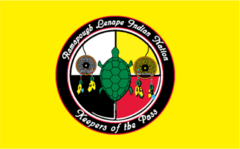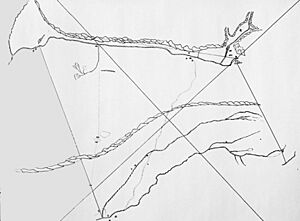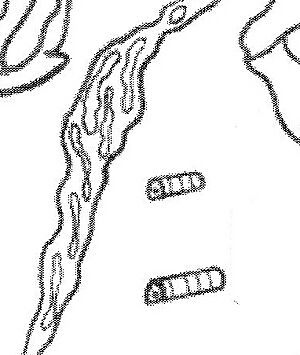Ramapough Mountain Indians facts for kids
 |
|
| Formation | 1980 |
|---|---|
| Founded at | Mahwah, New Jersey |
| Type | state-recognized tribe, nonprofit organization |
| Purpose | P84: Ethnic, Immigrant Centers and Services |
| Headquarters | Mahwah, New Jersey |
| Location | |
|
Membership (1992)
|
2,654 |
|
Official language
|
English |
|
Revenue (2019)
|
$34,222 |
| Expenses (2019) | $38,084 |
|
Formerly called
|
Ramapough Mountain Indians |
The Ramapough Lenape Nation is a Native American group recognized by the state of New Jersey. They were once called the Ramapough Mountain Indians. They are also known as the Ramapough Lunaape Munsee Delaware Nation.
About 5,000 members of the Ramapough Lenape Nation live in the Ramapo Mountains. This area is in Bergen and Passaic counties in northern New Jersey. Some also live in Rockland County in southern New York. This region is about 25 miles (40 km) from New York City.
The Ramapough Lenape Nation is recognized by the state of New Jersey. However, the United States government does not recognize them as a federally recognized Native American tribe. Their main office is on Stag Hill Road, on Houvenkopf Mountain in Mahwah, New Jersey. Since January 2007, Dwaine Perry has been the chief of the Ramapough Lenape Nation.
The Ramapough Lenape Indian Nation says they are descendants of the Lenape people, also known as the Delaware people. However, the Bureau of Indian Affairs (BIA) did not find enough proof of this Lenape ancestry. This decision was later confirmed after an appeal.
Contents
Seeking Federal Recognition
The Ramapough Mountain Indians (RMI) tried to get federal recognition as a Native American tribe. They sent a letter to the Bureau of Indian Affairs (BIA) in 1979. Federal recognition means the U.S. government officially recognizes them as a tribe.
In 1996, the BIA decided not to recognize the Ramapough Mountain Indians. The BIA explained that a group needs to show they have lived in a specific area as American Indians. They also need to show they are descendants of a historical Indian tribe.
The BIA found that the Ramapough community had existed as a distinct group from about 1870 to 1950. However, the BIA said this community was not seen as "American Indian" during that time. They also said there was no clear proof that the members were descendants of a historical Indian tribe.
Many tribes were suggested as possible ancestors for the Ramapough, like Munsee, Minisink, and Lenape. But the BIA found no documents connecting the earliest Ramapough ancestors to any tribes that lived in New York or New Jersey. The Ramapough appealed this decision, but the BIA confirmed their original decision in 1998.
State Recognition in New Jersey
In 1980, the state of New Jersey officially recognized the Ramapough as an Indian tribe. This happened through a special resolution. The resolution stated that the Ramapough Mountain People are descendants of the Iroquois and Algonquin nations. It officially named them the Ramapough Indians.
The tribe asked their New Jersey Assembly member, W. Cary Edwards, for state recognition. After some research, Edwards and another Assemblyman introduced a resolution. It passed the Assembly and the Senate in 1980.
At that time, New Jersey did not have clear rules for recognizing tribes. The state resolution also asked for federal recognition for the Ramapough, but this request was not binding for the federal government. New Jersey has also recognized two other tribes: the Nanticoke Lenni-Lenape and the Powhatan Renape. These groups are descendants of the Algonquian-speaking Lenape and Powhatan peoples.
Because of growing interest in Native American issues, New Jersey created the Commission on Native American Affairs in 1995. This commission helps address issues faced by Native Americans in the state. The Ramapough Nation is also a member of the National Congress of American Indians (NCAI). This group recognizes them as an indigenous people.
The Ramapough Indians say that New York State also recognized them in 1979. However, experts who have studied state recognition processes say that New York does not have a separate process for recognizing Indian tribes. New York has never officially recognized the Ramapough.
Understanding the Name
The Ramapough Lenape Nation was previously known as the Ramapough Mountain Indians. They have also used the name Ramapough Lunaape Munsee Delaware Nation.
Before the 1970s, people often called the group "Jackson Whites." This was a disrespectful term. Legend says it came from a type of potato or meant "Jacks and Whites." This reflected their multiracial background.
People outside the community thought the Ramapough were descendants of runaway slaves ("Jacks") and white people. Some believed these white ancestors included Dutch settlers and Hessian soldiers. Hessians were German soldiers who fought for the British during the American Revolution. These people were often seen as outsiders by the main British American population. It was thought they fled to the mountains after the Revolutionary War. However, there is no proof that slaves or Hessian soldiers married into the tribe.
The group rejects the names "Jacks" and "Jackson Whites" because they are offensive. They also reject the stories linked to these names. In 1880, a newspaper first printed the term "Jackson Whites." An article in 1911 said it was used to show contempt. Instead, the group called themselves "The Mountain People."
A historian named David S. Cohen said that these old stories were just legends, not true history. He wrote that the legend was a way to spread wrong and disrespectful ideas about the Mountain People. He believed some of the group's ancestors were multiracial, free Afro-Dutch people. They had moved from lower Manhattan and became landowners in the 1600s.
History of the Ramapough People

Many local historians, family researchers, and archaeologists have studied the Ramapough people. Their understanding has changed as new research has been done. Like other multiracial groups seeking to be recognized as Native American tribes, the Ramapough Mountain Indians have faced different opinions. People disagree about how important ethnic ancestry is compared to cultural identity and community life for a group to be recognized as a distinct culture.
Historian David Cohen found that early settlers in the Hackensack Valley included "free black landowners" and "mulattoes with some Dutch ancestry." These people were among the first to settle in the Hackensack River Valley of New Jersey. Some of these early free people of color may have moved west into the mountains. Surnames like Van Dunk, DeGroat, DeFreese, and Mann are common among the Ramapough.
Edward J. Lenik, an archaeologist, disagrees with Cohen's ideas about African-European ancestry. He believes that the Ramapough are descendants of local Munsee-speaking Lenape (Delaware) Indians. He says these Indians fled to the mountains in the late 1600s to escape Dutch and English settlers. It is well known that European settlers often forced Indian tribes to move and resettle.
How the Tribe is Governed
The Ramapough Mountain Indians have a government led by a chief and a council. In 1978, they formed a nonprofit organization. That same year, they asked the federal Bureau of Indian Affairs to recognize them as a tribe. They also organized themselves into clans for self-government: the Wolf, the Turtle, and the Deer. These clans are linked to their three main settlements in Mahwah, Ringwood, New Jersey, and Hillburn, New York.
Recent Activities
In 1995, New Jersey created a Commission on American Indian Affairs. This commission has seats for the recognized tribes, including the Ramapough Mountain Indians. It also has seats for other Native Americans living in New Jersey.
In 2006, a Ramapough Lenape man named Emil Mann was killed by a New Jersey State Parks Police ranger. This happened during a confrontation involving ATVs. His family sued the state. The governor of New Jersey met with the Ramapough Lenape and other Native Americans to improve relations. An investigation was done, and one of the rangers was charged.
In August 2006, Governor Jon Corzine created the New Jersey Committee on Native American Community Affairs. This committee looked into issues like civil rights, education, and health care for Native Americans in New Jersey. The committee's report in 2007 mentioned "lingering discrimination" and "ignorance of state history and culture" in how Indian people were treated.
State and federal officials have also worked with the tribes on other issues. For example, before the 2010 census, officials talked with the recognized tribes. They wanted to find ways to get accurate counts of their people. The Census Bureau recognizes State Designated Tribal Statistical Areas (SDTSA). These areas are identified by states and tribes to find places where many American Indians live outside of reservations. In New Jersey, these areas include Passaic and Bergen counties for the Ramapough Mountain Tribe.
Tribal Membership Rules
To become a member of the tribe, a person must have at least one Ramapough parent.
Environmental Concerns
The tribe has faced environmental problems because of company projects on or near their land.
The Pilgrim Pipeline Project
Since 2017, the tribe has been fighting against the Pilgrim Pipeline. A company called Pilgrim Pipelines Holdings, LLC plans to build two pipelines through the tribe's land. These pipelines would carry fuels like gasoline and diesel north. They would also carry crude oil from the Bakken Formation south. The pipelines would run between Albany, New York and a refinery in Linden, New Jersey.
The pipeline would also go through the Ramapo Mountains and Ramapo Pass. To show support for Standing Rock, tribal members started a protest camp in Mahwah, New Jersey in 2016. This camp, called Split Rock Sweetwater, protests the Pilgrim Pipeline.
Ramapough in Media
Films
- Mann v. Ford (2011) is a documentary about a lawsuit. The Ramapough Lenape Indian Nation sued Ford. This film is often shown on HBO. It follows the tribe's five-year legal fight and how they reached a settlement with the company.
- American Native (2013) is a documentary that shows the Ramapough Lenape Nation's efforts to gain federal recognition. It also highlights the challenges they have faced, such as losing land, racism, and missing records.
- The movie Out of the Furnace (2013) is a fictional drama. It is about communities living in the Ramapough Mountains. Tribal leaders and officials from Mahwah asked people to boycott the film. They felt it showed the Ramapough Lenape Nation in a bad way. The film's makers said the movie was "entirely fictional" and not based on any real group. Nine members of the group sued the filmmakers. However, a judge dismissed the lawsuit, saying the film did not directly refer to any of the people who sued.
- Akuy Eenda Maawehlaang: The Place Where People Gather (2019) is a 28-minute documentary.
Television
- The Red Road (2014) is a six-part miniseries made for television by HBO and SundanceTV.
|


